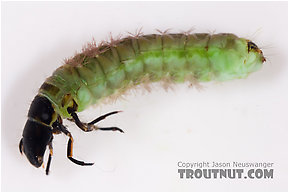Blog & Latest Updates
Fly Fishing Articles
Insects by Common Name


Caddisfly Genus Psilotreta (Dark Blue Sedges)
Taxonomic Navigation -?-
Kingdom
Animalia (Animals)
» Phylum
Arthropoda (Arthropods)
» Class
Insecta (Insects)
» Order
Trichoptera (Caddisflies)
» Family
Odontoceridae
» Genus Psilotreta (Dark Blue Sedges)
| Species in Psilotreta | ||
| Psilotreta frontalisDark Blue Sedge | 0 | 0 |
| Psilotreta labidaDark Blue Sedge | 2 | 20 |
4 species aren't included.
Common Name
| Match | Common Name |
| Dark Blue Sedges |
Where & When
The most important species are found in the East. They often emerge together with the large Green Drake mayflies, Ephemera guttulata, which can be reduced to a masking hatch (Masking hatch: When two types of insects are on the water simultaneously and the trout are feeding on the less noticeable one, the more prominent insect (usually brighter and/or larger but less abundant) is known as a masking hatch.) when these caddisflies are thick.
Hatching Behavior
Because the larvae gather in large numbers on certain rocks to pupate, fishing the emergence demands unusual tactics from the angler. Gary LaFontaine describes them in Caddisflies:
A hundred or more cases might be stacked in layers on the underside of a particular rock. When the emergence period begins the pupae pop continually from this area. They escape from the cocoon and wash out from under the rock, creating a food line for trout on the downstream side of the pupation site. During the peak evening hours the emerging pupae may create feeding situations in only a small part of the stream. They attract trout into these prime zones (which fly fishermen can find beforehand by searching for the clusters of pupae).
Egg-Laying Behavior
Time Of Day: Evening
The females flop onto the surface and flitter around in a non-stop commotion there until they're through laying their eggs. Trout key on the fluttering insects and reportedly reject still imitations.Larva & Pupa Biology
Diet: Omnivorous
Substrate: Silt, sand, or gravel
Environmental Tolerance: Prefers cool streams
Shelter Type: Horn-shaped sand and gravel cases
These are burrowing caddisflies, and their cases are extremely strong. They live in the silt, sand, or gravel for most of their lives, where they are not vulnerable to trout. They expose themselves only when they are ready to pupate, when they congregate on specific rocks.Substrate: Silt, sand, or gravel
Environmental Tolerance: Prefers cool streams
Shelter Type: Horn-shaped sand and gravel cases
Pictures of 2 Caddisfly Specimens in the Genus Psilotreta:
Male Psilotreta labida (Dark Blue Sedge) Caddisfly Adult View 11 Pictures
View 11 Pictures
 View 11 Pictures
View 11 PicturesCollected June 1, 2007 from the West Branch of the Delaware River in New York
Added to Troutnut.com by Troutnut on June 4, 2007
Added to Troutnut.com by Troutnut on June 4, 2007
Psilotreta labida (Dark Blue Sedge) Caddisfly Larva View 9 Pictures
View 9 Pictures
 View 9 Pictures
View 9 PicturesCollected March 30, 2007 from Fall Creek in New York
Added to Troutnut.com by Troutnut on April 2, 2007
Added to Troutnut.com by Troutnut on April 2, 2007
Your Thoughts On Psilotreta:
Top 10 Fly Hatches
Top Gift Shop Designs
Eat mayflies.
Top Insect Specimens
Miscellaneous Sites
Troutnut.com is copyright © 2004-2024 Jason
Neuswanger (email Jason). See my FAQ for information about use of my images.
 privacy policy
privacy policy
